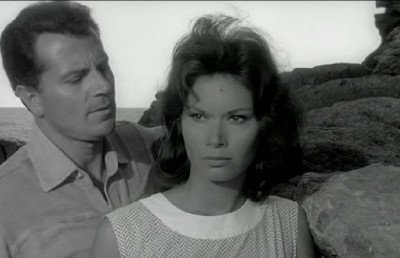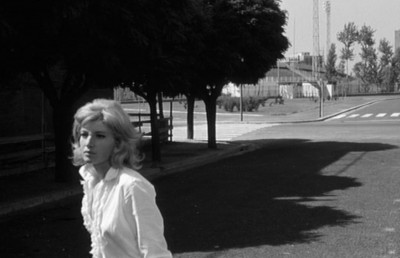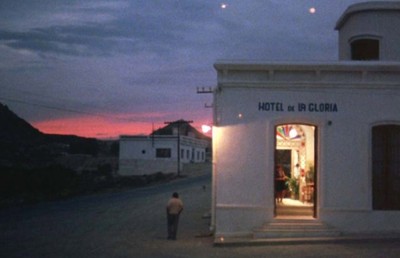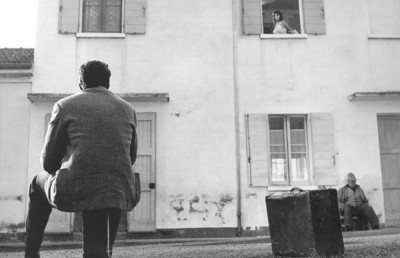Zabriskie Point (1970, Antonioni): A Scene by Scene Analysis of a Troubled Masterpiece
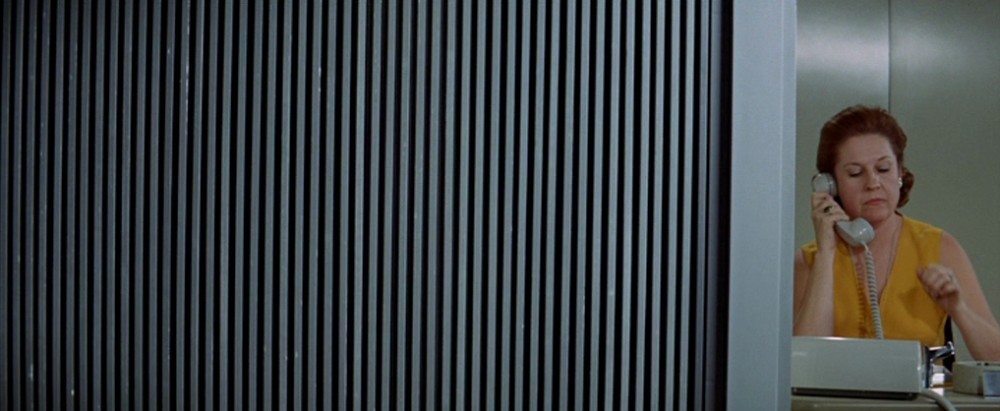
With its 40th anniversary just around the corner, a reassessment of Zabriskie Point within Antonioni’s body of work is long overdue. Zabriskie Point was the middle of three films Italian director Michelangelo Antonioni made for MGM: Blow-Up (1966) being the first and The Passenger (1975) the third. Of the three American films each have had their own idiosyncratic mini-history and cultish associations. Zabriskie Point is the one which did the poorest at the box-office (a mere $900,000 during its brief theatrical run on a budget of 7 million dollars, compared to the art house success of Blow-Up) and suffered the most severe critical backlash. Even avid Antonioni supporters, like Seymour Chatman, found fault with it at many levels (its overall premise, the abandonment of the political, the acting, etc.). Many of the negative comments arose from a misconception: that Antonioni’s intention was to make a political film about the American Counterculture. Antonioni was on record several times denying this, and arguing that he was interested in isolating two characters, one who was directly involved in the student demonstrations (Mark) and one who became indirectly involved through her association with the other, Daria. Still, it is hard to absolve Antonioni of all guilt for designing a film which, at least on the surface, would appear to be ‘about politics.’
“I think that this film is about what two people feel. It is an interior film. Of course, a character always has a background” (Antonioni, 305).
This ‘background’ can have two senses. The obvious one being the pulse of the late 1960s Civil Rights Movement as expressed by the student demonstrations against (among other things) the Vietnam War. A less obvious sense of ‘background’ and the one which I will stress as being the true focus of interest for Antonioni is the actual physical landscape and urban architecture of Los Angeles and the Death Valley desert. For anyone who knows Antonioni’s past masterpieces this would not come as a surprise. If all great directors could be reduced to one major contribution to cinematic language, for Antonioni it would be his uncanny ability to wed character emotion to landscape. In my scene specific analysis of Zabriskie Point I will pay special attention to this aspect and attempt to contextualize the film within his earlier works, and to other allusions the film evokes for me.
In his great Italian films Antonioni dealt almost exclusively with the class he knew best, his own, the Italian middle class. I find it strangely ironic that a 57 year old, middle-class Italian art director –consciously or not– was seen (by some US critics) as a spokesperson and defender of the American Counterculture! If there is any weight given to the negative criticism leveled at Zabriskie Point it is largely because Antonioni was dealing with a class he knew very little about (working class), [2] a generation far removed from his own, in a country (the United States) he knew little about. But in whatever country Antonioni worked (and he worked in many, China, England, Italy, Central Africa, Spain, Germany) he knew how to express character interiority through physical geography. This is something he could not forget, regardless of where he was working.
Antonioni was the sort of director who thought long and hard about how technical issues would impact on style, form and meaning. I’ll highlight an example using the aesthetic choices he formed around the use of camera lens type. In his first set of feature films (Cronica du un amore, 1950, La signora senza camelie, 1953, I Vinti, 1953, Le amiche, 1955, Il Grido, 1957) Antonioni used the wide angle lens exclusively. The wide angle lens (approximately 50mm with a 35mm camera) has the technical qualities of opening up the field of vision, expanding space and providing a greater depth of field. In his middle, mature period, where he made his most famous films, the alienation trilogy (L’Avventura, 1960, La Notte, 1961, L’Eclisse, 1962) he began to incorporate a telephoto lens (roughly 100mm with a 35mm camera) with a wide angle aesthetic. The technical qualities of the telephoto lens tends toward a closing of the field of vision, a compression of space, and a reduction in depth of field.
Il deserto rosso (1964) marked an important moment in Antonioni’s stylistic development because it was his first color film but also his first film to use the telephoto lens exclusively; and it was his most abstract film. His decision to go with the telephoto lens was no doubt related to this latter fact, since the particular properties of the telephoto lens –flattening the frame, throwing portions of the frame out of focus– is conducive to abstraction: forcing the audience to look for things other than subject/representational, such as form, line, color, texture, and shape, rendering a ‘painterly’ quality to Il deserto rosso. Antonioni resorted to a mixed lens style for Blow-up but returned to the telephoto aesthetic for Zabriskie Point.
What is interesting is that by the late 60s the telephoto lens was associated with a certain aesthetic: the cinema vérité, cinema direct, observational documentary/TV. The zoom lens which brought the viewer into an objective view of different characters, panning from one to another, zooming in/out, became a signifier for a certain newly formed (compared to earlier documentary) ‘truth’ factor. Antonioni played with this aesthetic convention by using it at the outset of the film, but then abandoning it for the more ‘painterly’ quality (something which no doubt shaped the critical confusion over the film’s lack of political continuity). What follows is a scene by scene breakdown [2] highlighting the two central critical areas I have introduced in my opening: the importance of landscape/architecture and the aesthetics of the telephoto lens.
Scene 1: Student Meeting (0’00”-8’50”) [3]
“If I had wanted to do a picture about student dissent, I would have continued the direction I took at the opening with the student-meeting sequence” (Antonioni, 94).
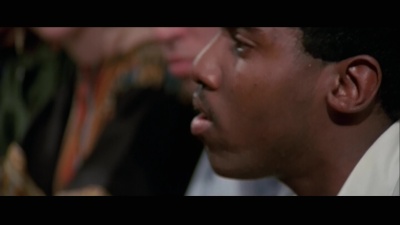
Antonioni begins the ‘deception’ right from the first scene of the film, introducing the students in a typical vérité style, panning and zooming from face to face, cutting quickly, but with the very next scene announces a shift away from vérité realism to an abstract expressionism, which becomes blatant if the opening is compared with the ending. The cinema vérité style of this opening sequence will soon be abandoned for a more poetic and surrealist style. I would add that this style, with its foreshortened, fragmented space, underscores the divisions within the group rather than the sense of unity that would be expected at a student meeting with goals of collective action. The implosion of the vérité style is subtly announced in moments of illogical spatial editing, such as when continuous dialogue is matched with successive elliptical shots of Mark (Mark Frechette), starting with a zip pan from a perturbed looking Mark, to Mark smoking a cigarette, to Mark rubbing a pack of yellow matches against his mouth. So much for temporal and spatial realism.

Mark ends the meeting for both him and us with his rhetorical interjection, “ I’m willing to die too, but not out of boredom,” as he makes his dramatic exit from any sense of collectivity. Mark’s distaste for meetings and talk seems shared by Antonioni, as there is just about more dialogue in this scene than in the rest of the film combined!
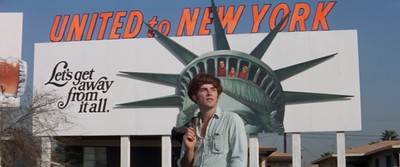
Scene 2: Introducing Daria (8’50”-10’00”)
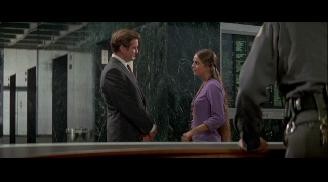
In this brief scene we are introduced to Daria (Daria Halprin) and Lee Allen (Rod Taylor), head of a land development company called the Sunny Dunes (the enemy) in the lobby of an imposing modern business complex.
Scene 3: Billboards (10’00”-13’40”)
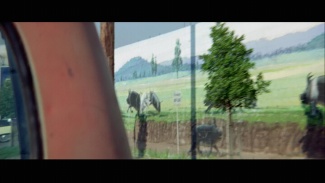
This scene begins with a series of languid pans across large city billboards filling the frame completely with images of (mainly) farming. The scene then picks up Mark and his friend Marty driving in a pickup truck, but the vérité style camera is misaligned with (non-diegetic?) industrial sounds reminiscent of the factory sounds from Il deserto rosso. The function of the scene is to veer the viewer away from the pseudo-political opening to what Antonioni is interested in: abstraction (while at the same time signaling Mark’s alienation from the ‘collective’). The telephoto lens is used to create vertiginous movement, fragmenting the space between Mark, his truck, and the billboards. (The scene is also reminiscent of the tunnel ride in Solaris.) We learn that Mark has a sister, Alice, seen driving by in a sports car. Mark drops his friend off to join a picket line in front of the university’s administration building.
Scene 4: Civil Disobedience at the Police Station (13’40”-17’00”)
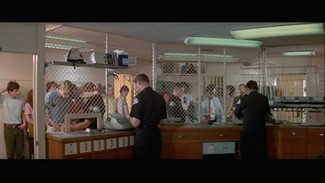
The physical separation of the police and the citizens (students, professors) by a grated fence symbolizes the police as a class apart from the main protagonists of the film. The police have nothing in common with the students, going about their job with indifference and lacking any sense of humanness or humor (a joke with the punch line ‘Carl Marx’ washes over them). The scene returns briefly to the vérité style of the opening.
Scene 4: Buying a Gun (17’00”-18’20”)
Mark and another student enter a gun shop. Their request to “buy some guns right away for self-defense” is at first met with some resistance by the clerk (“You can pick them up in four or five days…”). A simple verbal appeal to “keeping their women safe” in their “borderline” neighborhood melts away any gun restriction laws, and the clerk eagerly sells them a 38 caliber hand gun. As they are leaving the store a second clerk gives them a tip: “One other thing about the law. You can protect your house. If you shoot him in your backyard be sure to drag him into the house.” The scene, strangely enough, reminds me of a similar scene in the 1974 exploitation film The Candy Snatchers (Guerdon Trueblood). In both scenes young protagonists with violence in mind enter a gun shop; their request to purchase a gun is first met with mild resistance, but then they are willingly accommodated, and even given ‘advice’ on how to stay within the letter of the law.

Scene 5: Sunny Dunes Promo (18’20”- 20’40”)
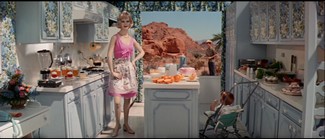
This brief scene depicts a group of business men in a boardroom watching promotional video on a new housing development by Sunny Dune Land Development company. The scene veers toward satire, as Antonioni cuts between the all-male board members and the miniature model reproductions of the sterile housing community. The scene cuts to shots of Lee Allen driving to the meeting. On the car radio is a report on student unrest at a university campus. Tellingly, neither Lee nor the person driving with him seem to take any heed of the report.
Scene 6: Preparing for Action (20’40”-21’30”)

The sound of the radio report bridges a transition to Mark and a few other students listening to the same report in a shabby apartment, as they are seemingly preparing to take some type of violent action. We see Mark place a gun between his pant leg before he leaves. As Mark drives off the shot cuts to Lee’s car arriving at the Sunny Dunes Development headquarters.
Scene 7: Sunny Dune Headquarters (21’30”-22’40”)
Lee arrives to join the meeting.
Scene 8: Daria on the Road (22’40”-23’15”)
This scene opens with an aerial shot of the vast LA highway and surrounding desert landscape. It cuts to Daria in her car stopping for directions on her road map. We learn in the next scene that she is driving to meet Lee at his Phoenix area desert estate for a business meeting.
Scene 9: Lee’s Faustian Empire (23’15”-25’40”)
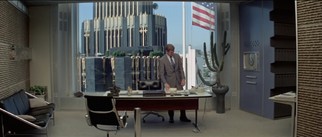
This is the first scene to feature Lee in his environment, his office, and Antonioni overwhelms the human with the interior/exterior juxtapositions. We are ‘alienated’ from Lee through the way Antonioni shoots him in his office space, recalling Jacques Tati (Playtime) in its harsh, sterile, inhuman modernity. A shot of Lee’s secretary frames her to the extreme right of the frame, recalling similar out of balance framing from La Notte.

An unusual (for Antonioni) low angle from below Lee’s desk frames his crotch area in the middle of the frame against a modern building seen in the background through the large window, a playful phallic joke at the patriarchal nature of the Sunny Dunes empire. Lee crosses his legs to form a powerful diagonal line right to left from the telephone intercom under the desk, his legs, and the building seen through the window. The US flag at the top of the flag pole blowing in the wind caps off the dialectical association of the powerful (big business/Government) and the powerless (the students/Counterculture). The connection between Lee/Sunny Dunes Development and the US Government is extended to the Law with the striking edit to the next scene: an extreme close-up of a police officer in full riot gear.
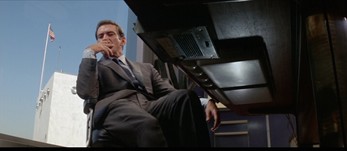
Scene 10: Restoring Order (25’40”-30’00”)
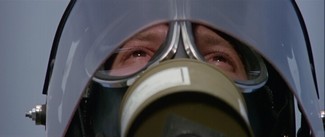
The mask, which only exposes the officer’s eyes, renders a sense of anonymity to the police, as they proceed to break up the huge crowd of student demonstrators on the university grounds. William Arrowsmith in his excellent book on Antonioni notes that Antonioni differentiates between the police at work, as a group collective, where they behave violently, and when they are out of uniform, and in a more relaxed and playful state. The anonymity of their uniforms, with their faces hidden behind their masks and riot gear, allows them to behave anti-socially, for the ‘good’ of social order (p. 138). The vérité style returns to depict injured and bleeding students being led away on stretchers. The tension escalates. Tear gas bombs are thrown into the school, forcing students to exit. A black man runs out of the building. The innocent gesture of tucking his shirt into his pants is interpreted as a move for a gun and the young man is shot dead by the police. The following sequence of edits to Mark reacting to the shooting by going for his gun and a police officer being shot makes it clear to the viewer that the bullet that felled the officer did not come from Mark’s gun. Mark runs off, but his fate has been sealed.
Scene 11: Taking to the Air (30’00”-38’00”)
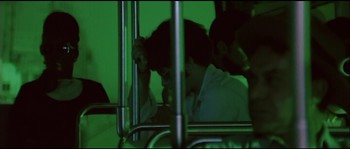
In a fascinating bit of Antonioni-esque ‘environmental subjectivity’ we see Mark seated on a city bus, his head bowed. The image has a green hue, shot with a green filter. The source of this green hue is uncertain at first. The scene cuts to a closer shot of Mark and we notice that he is wearing tinted sunglasses. Are they tinted green? He disembarks and we notice that the bus windows are tinted green. Mark goes into a deli to call his friend Marty. A couple of older blue collar workers eating at the counter reflect the theme of generational tension in their silent, mutual disapproval of Mark. Mark’s request for a sandwich handout is turned down by the cook. Mark leaves the deli and quietly walks into a hangar area and hijacks a small plane, a gesture which relates to other Antonioni films in the use of flight as a form of temporary escape (see the L’eclisse clip from the Bloom essay in this issue). The plane has the words ‘Lilly 7’ written on its side, and sports a pink and beige color pattern that foreshadows the tone and texture of the desert. When he gets high into the air Antonioni resorts for the first time to free-flowing, guitar rock music which captures Mark’s euphoric state, while typifying the music of his generation. In what can only be described as a sublime edit, the shot of Mark in the cockpit, the music blaring loudly, gives way abruptly to aural silence and an in-flight aerial camera movement descending toward the sand dunes. The camera continues to descend and picks up Daria driving along the highway in a retro 1950s Buick coup. Softer rock music emanating from her car radio becomes audible as the camera nears her vehicle. The ethereal movement of the camera, the soft music, and the pinkish desert sand (nature) introduces the ‘feminine’ (Daria).
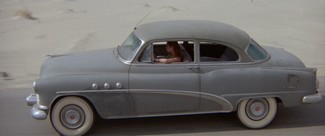
Scene 12: The Roadside Café (38’00”-45’00”)
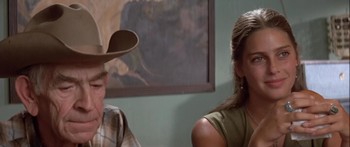
The scene cuts to Lee at his office receiving a phone call from Daria, who has stopped at a desolate roadside café. The scene crosscuts between them, as Lee tries to locate her on a map to guide her to his Phoenix estate. Daria makes small talk with the ‘locals’ including a old washed up boxer and the bartender. The bartender tells her that the man she is working for is going to ‘kill’ the area. The implication being that big corporations come in and lay the past to waste. The sense of a place forgotten by time is present throughout this scene: the washed up boxer and comatose man in the diner; the homeless children, the upturned car, the smashed up piano; the stairs leading up to a porch with no home. The bartender laments a group of problem children that were transferred from Los Angeles to his town. This sets up a strange altercation between Daria and a horde of scavenger children outside the diner, a scene which has always struck me as an echo of the scene from Welles’ The Trial where Anthony Perkin’s Josef K. character is chased by an aggressive posse of children (only here the scene has a sexual undertone, as one of the kids asks Daria, “Can we have a piece of ass”). Daria runs away from the attacking children and drives off to safety. As her car rushes out of frame the camera remains on the diner and tracks /zooms-in to the sad image of an old man (the one pictured in the photo above) sitting alone at the counter with his beer and cigarette, a plaintive country song playing on the soundtrack (shades of Edward Hopper).
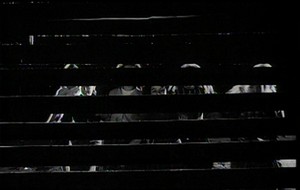
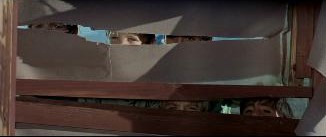
To add to Arrowsmith’s earlier point about the police collective, a similar dynamic occurs in this strange scene where Daria is attacked by a group of scavenger-like children outside the diner. Individually the children are passive; as a group they threaten.
Scene 13: Cat and Mouse Game (45’00”-55’00”)
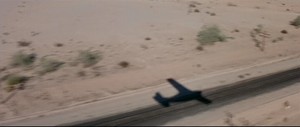
As the film nears its midway point we get the meeting of the two central protagonists, Daria and Mark, in the desert. A playful game of chicken ensues between Mark’s plane and Daria’s car (foreplay?). Mark tosses down a red t-shirt, eventually lands his plane and they meet. When asked where she is heading Daria replies “Phoenix,” the name of the bird that rises from the ashes and gets reborn, foreshadowing her political awakening at the film’s end. The scene also opens on the bird-like shadow of Mark’s plane on the road (and later the plane is painted like, to quote Mark, “a prehistoric bird with its genitals hanging out”). When she asks Mark if he really stole the plane he replies, “I needed to get off the ground.” They drive off together.
Scene 14: Zabriskie Point (55’00”-75’00”)
“Well, as an author I claim the right to delirium, if for no other reason than today’s delirium might be tomorrow’s truth” (Antonioni, 96).
Mark and Daria sit on a rock edge overlooking the desert expanse. As they make small talk, the camera dollies around them in a 180 degree circular arc, a gesture which may have influenced another great Death Valley desert film, Gus Van Sant’s Gerry, where the camera dollies a full 360 degree around Casey Afleck.


A casual line reveals Daria’s apolitical nature, which sets up her conversion/political awakening at the end:
Mark: “Hear any news about the strike?
Daria: “No, I prefer music.”
They eventually make their way down below and begin to make love. Jerry Garcia’s soulful solo blues guitar wraps itself around the scene like aural dust. Just like Garcia’s improvisational music, Antonioni begins to improvise on reality. Phantom couples (played by members of Joe Chaikin’s Open Theatre) begin to appear everywhere around Mark and Daria, play fighting, rolling in the sand, blending themselves into the landscape (aided by the flattening, compressing lens). This bizarre scene is the one that perhaps most baffled viewers and critics, when in fact it contains the most direct thematic link to his earlier works and functions as a soulful antidote to the central negative dynamic portrayed in his alienation tetralogy: “sick eros.”
In his famous alienation tetralogy ( L’Avventura, La Notte, L’Eclisse, Il Deserto Rosso) Antonioni depicted the Italian middle class as emotionally and spiritually vacant. Antonioni characterized this modern, post-war Italian society as suffering from what he called “sick eros” (sex that is used to fill an emotional/spiritual void). He explained this interesting concept in a statement at the 1960 Cannes festival following the horrendous reception of L’Avventura:
Why do you think eroticism is so prevalent today in our literature, our theatrical shows, and elsewhere? It is a symptom of the emotional sickness of our times. But this preoccupation with eroticism would not become obsessive if Eros was healthy, that is, if it were kept within human proportions. But Eros is sick; man is uneasy, something is bothering him. And whenever something bothers him, man reacts, but he reacts badly, only on erotic impulse, and he is unhappy. The tragedy in L’Avventura stems directly from an erotic impulse of this type: unhappy, miserable, futile. To be critically aware of the vulgarity and the futility of such an overwhelming erotic impulse, as is the case with the protagonist in L’Avventura, is not enough or serves no purpose. And here we witness the crumbling of a myth, which proclaims it is enough for us to know, to be critically conscious of ourselves, to analyze ourselves, in all our complexities and in every facet of our personality. The fact that matters is that such an examination is not enough. It is only a preliminary step. Every day, every emotional encounter gives rise to a new adventure. For even though we know that the ancient codes of morality are decrepit and no longer tenable, we persist, with a sense of perversity that I would only ironically define as pathetic, in remaining loyal to them. Thus, the moral man who has no fear of the scientific unknown is today afraid of the moral unknown. Starting out from this point of fear and frustration, his adventure can only end in a stalemate (Michelangelo Antonioni, 33-34).
One of the Counterculture’s most symbolic anti-establishment gestures was a return to a Romanticist notion of free and natural love and sexual liberation. To return to a question many critics were probably asking back in 1970 –what affinity did Antonioni have with the American Counterculture?– undoubtedly Antonioni saw the energized sexuality associated with youth and the 1960s ‘free sex’ mantra as an antidote to “sick eros”. And what better to drive the scene than the music of Jerry Garcia, the leader of the band most strongly identified with the 1960s/early 70s ‘free sex,’ The Grateful Dead.
Scene 15: The “Red” Desert (75’00”-80’00”)
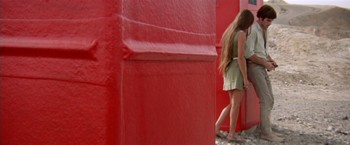
Daria and Mark return to the road, but spot a state trooper parked on the road ahead. Mark, wanted for the stolen plane, and perhaps murder, hides behind one of two bright red portable toilets that appear stranded in the desert (an homage to Il deserto rosso??/??Red Desert ?) while Daria talks to the state trooper. Mark takes his gun out and aims it at the trooper from behind the stall, but luckily the situation is diffused as the trooper leaves the scene. The encounter with the state trooper in the middle of nowhere has echoes to Marion Crane’s similar encounter in Psycho (only here Daria is outside her car). Mark decides to return the plane back to the air strip. Like Marion Crane who decides to return the stolen money, only to be killed in the process, Mark will eventually be shot dead by overzealous policemen in the process of returning the ‘borrowed’ plane. (Psycho also opens with a title card that situates the action in ‘Phoenix’.)
Scene 16: The Bird Soars Again (80’00”-93’45”)
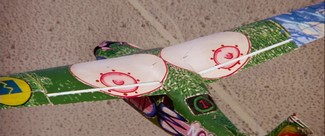
Daria and Mark paint the plane a psychedelic mess of colorful slogans and pop art graffiti in preparation for its rightful return. The scene intercuts between Daria driving to her destination in Phoenix and Mark soaring overhead toward the hangar, where a fleet of police officers await. As soon as he lands the plane he is chased by police cars. The police fire rounds before giving any warnings. The police approach the plane and find Mark’s inert body slouched over the steering wheel.
Scene 17: The Rebirth (93’45”-95’00”)
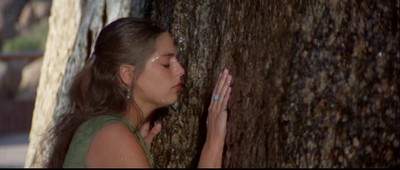
“If I had to sum up my impressions of America, I would list these: waste, innocence, vastness, poverty” (Antonioni, 92).
The scene cuts back to the desert. A radio report coming from Daria’s off-screen car says that Mark was shot by an unidentified cop when their attempts to pull him over failed, but we know the facts to be different. We feel his death as a useless loss. Like Aldo from Il Grido, Mark leaves the social collective only to die upon his return. The only positive his death will serve is to ‘reawaken’ Daria, who does not utter a single word after the death of Mark. Her path to Lee’s Phoenix area desert estate is telling, a symbolic visualization of her ‘rebirth’. She stops off at a green, cacti filled space to meditate (what she went there for in the first place). Mournful country blues guitar music accompanies one of the most beautiful moments in the film. Struck by the news of Mark’s death, a dejected Daria stands by her car looking out aimlessly. The camera frames her from behind, the telephoto lens separating her from the trees and greenery in the background. She sways her body gingerly from left to right, in harmony with the blowing foliage, as if to suggest her ‘political’ sway (93’30”-94’00”).
After the thirty second long take, she turns away quickly and, with a look of new found determination, takes to the road. Daria finally arrives at Lee’s desert estate to join him for a business meeting. She enters the home by way of the back, going through a portal, past a swimming pool, through a womb-like granite tunnel which has –conveniently– a small waterfall. She stops to look up at the waterfall and is overwhelmed by emotion. She begins to cry, then rests her face and hands against the inner wall where the water runs down, allowing the water to fall over her body (see frame still above). Antonioni was never one to rely on symbolic imagery, but this scene is a clear instance of it: purification/rebirth through water being a common symbolic gesture (just think of Marion Crane taking a shower after the robbery, or the shower Maria takes in Tarkovsky’s Mirror after confirmation that she did not make a printing error, etc.).
Her rebirth is confirmed through her subsequent behaviour toward Lee and his ‘establishment’ home. She shows all the classic signs of being ‘alienated’ in the environment. She does not talk to Lee (compared to earlier), walks aimlessly through the estate, is framed looking through barriers, and smiles when making telling eye contact with a member of the under-class, one of Lee’s servants (of Native origin). The latter gesture suggests a sense of working class empathy in Daria not evident in earlier scenes. The contact with the maid serves as her cue to leave Lee’s luxurious estate.
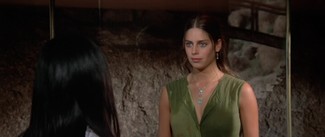
Daria’s ‘meandering’ walk in this scene make her a spiritual cousin to Antonioni’s earlier heroine’s, most notably Jeanne Moreau in La Notte or Monica Vitti in L’eclisse.
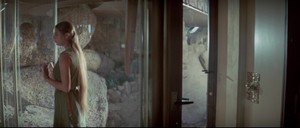
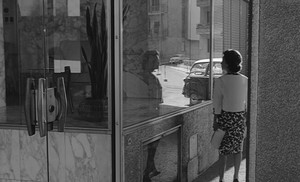
She begins to drive away but then stops a few hundred feet from the house. The scene cuts to the meeting between Lee and potential land buyers inside the house. After a brief, silent ‘fantasy’ image of the house exploding, a distraught Daria places her troubled head against the car seat and then gently caresses the red shirt which Mark gave her (the color red is symbolic throughout the film, suggestive of danger, death, Mark’s anti-conformism, and ultimately, Daria’s moral transformation, rather than any obvious allusion to Communism). The gesture of Daria caressing Mark’s shirt recalls similar gestures by Claudia (Moncia Vitti) in L’avventura, where she caresses the dress given to her by her friend Anna, who has mysteriously disappeared, and again later with Sandro’s shirt.

The focus soon shifts to Daria’s vivid imagining of the home being blown to (literal) smithereens, leading to one of the most experimental conclusions of any fiction film (perhaps matched only by Antonioni’s own L’eclisse). The five minute sequence is marked by Eisensteinian overlapping editing (the house explodes over and over again), a super slow motion cinematography, [4] and the abstract properties of the telephoto lens. Artifacts of consumer capitalism (a fridge, a television set, furniture, food, laundry detergent, clothes, Wonder toast bread, etc.) are transformed into kaleidoscopic colors and forms, accompanied by a manic rock score featuring primal screams and searing guitar solos. The final item to be exploded is the library, with hundreds of atomized books floating toward the camera. Can Antonioni be making a link to the opening scene (books linked to students/university) and the ‘explosion’ of the student revolution? (The use of super slow motion in this scene no doubt influenced Dario Argento’s similar use of hyper slow motion for the end of his giallo masterpiece Four Flies on Grey Velvet, made one year later in 1971.)
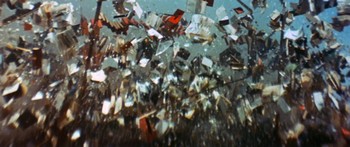
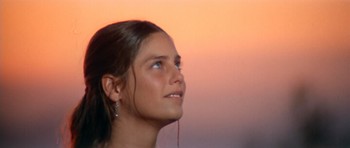
Recalling the earlier stark edit from noise to silence, the explosion fantasy ends on a cut to silence and a close-up of Daria’s smiling face. Behind her the sky is a beautiful orange, suggesting the ‘dawn’ of a new era. (An idea echoed in the lyrics of the closing Roy Orbison song “So Young”: “Dawn comes up so young. Dreams begin so young.”) As Daria drives off the camera tilts up to frame a beautiful golden sunrise (a shot which has its twin in Gerry). With such a rhetorically happy ending it is surprising that so many American critics attacked the film for being ‘Anti-American.’


While not at the level of Antonioni’s greatest works, Zabriskie Point is a fascinating continuation of Antonioni’s life-long interest in the mise en scene of human beings and physical space. With the span of time, perhaps we can finally enjoy the film for what it is rather than what it is not.
Endnotes
1 To be fair, Antonioni did deal with the working class in some of his early documentary (Gente del Po, 1947) and, most notably, in Il Grido, 1957.
2 For the sake of completeness I have decided to include every scene in the film, even though not each will yield productive material.
3 The time codes are taken from the recent MGM DVD. For the sake of neatness, in some cases the time codes were rounded out to the closest second. Hence they are meant to be a general guideline to the film’s structure and not an exact to-the-frame temporal breakdown.
4 According to James S. Williams, “special cameras were used here producing 3000 images per second” (55).
Bibliography
Michelangelo Antonioni. The Architecture of Vision. ed. Carlo di Carlo, Giorgio Tinazzi. American Edition by Marga Cottino-Jones, Marsillo Publishers, 1994.
William Arrowsmith. Antonioni: The Poet of Images. ed. Introduction and notes by Ted Perry. New York/Oxford: Oxford University Press, 1995.
James S. Willaims. “The Rhythms of Life: An Appreciation of Michelangelo Antonioni, Extreme Aesthete of the Real.” Film Quarterly (Fall 2008, 62:1): 46-57.



